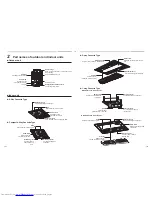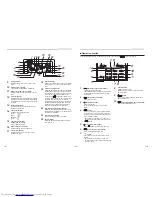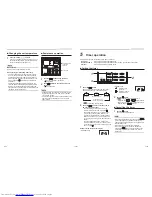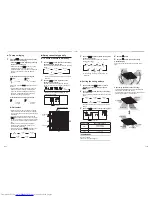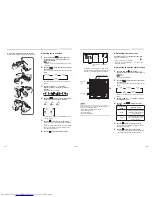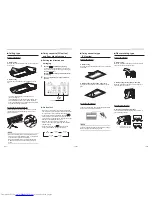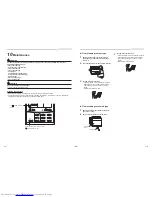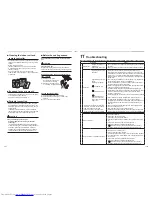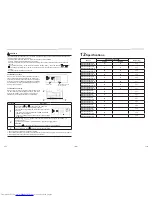
■
Cleaning the indoor unit and
remote controller
• Ask quali
fi
ed service person to clean the indoor units
for the models listed in the warning on the top of this
chapter.
• Wipe with a dry, soft cloth.
• If heavily stained, wipe off dirt with a cloth soaked
in lukewarm water. (Do not use water to wipe the
remote controller)
• Do not use benzine, thinner, scouring powder,
chemical cloth, etc. as those may cause deformation
or breakage.
■
If unused for over a month
• Leave the fan on for half a day or so to dry the inside.
• Turn off the main power switch.
• Clean the air
fi
lter and then attach it.
■
Periodic inspection
• After being used for a long period of time, the parts
may deteriorate or increasing malfunction risk, or the
drainage may worsen, due to heat, moisture, dust, or
general usage.
• In addition to the maintenance, it is recommended
that you have a inspection (charges apply) performed
by the dealer where you purchased the unit, etc.
CAUTION
4-way air discharge cassette type
•
Perform high-pressure cleaning for the heat
exchanger.
If commercially available detergent (strong alkaline
or acid cleaning agent) is used, the surface treatment
of the heat exchanger will deteriorate, which may
degrade the self cleaning performance. For details,
contact the dealer where you purchased the unit.
■
Before the cooling season
Ask a quali
fi
ed service person to clean the drain
pan
CAUTION
Clean the drain pan
Without cleaning, the drain pan may be
fi
lled with
waste, and water may over
fl
ow onto the ceiling or
fl
oor.
If you do not plan to use the unit for more
than 1 month
(1) Operate “FAN” mode.
Run the fan for about half a
day to dry the inside fully.
(2) Stop the air conditioner and
turn off the main power switch.
Checks before operation
(1) Check that the air
fi
lters are installed.
(2) Check that the air discharge or intake is not
blocked.
(3) Turn on the main power switch.
11
Troubleshooting
When the following symptoms are found, check the points described below before asking repair servicing.
Symptom
Cause
It is not a failure.
Outdoor unit
• White misty cold air or
water is out.
• Fan of the outdoor unit stops automatically and performs defrost
operation.
• Sometimes, hiss sound
is heard.
• Solenoid valve works when defrost operation starts or
fi
nishes.
Indoor unit
• “Swish” sound is heard
sometimes.
• When the operation has started, during the operation, or
immediately after the operation has stopped, a sound such as
water
fl
ows may be heard, and the operation sound may become
larger for 2 or 3 minutes immediately after the operation has
started. They are
fl
owing sound of refrigerant or draining sound of
dehumidi
fi
er.
• Slight clacking sound is
heard.
• This is sound generated when heat exchanger, etc. expand and
contract slightly due to change of temperature.
• Discharge air smells.
• Various smell such as one of wall, carpet, clothes, cigarette, or
cosmetics adhere to the air conditioner.
• “
” indication is lit.
• When cooling operation cannot be performed because another
indoor unit performs heating operation.
• Is outdoor temperature out of operation temperature range?
• “
” indication is lit.
• When the manager of the air conditioner has
fi
xed the operation
to COOL or HEAT, and an operation contrary to the setup
operation is performed.
• “
” indication is lit.
• When stopping the fan to prevent cool air blow at starting heating.
• Sound or cool air is
output from the stand by
indoor unit.
• Since refrigerant is
fl
owed temporarily to prevent stay of oil
or refrigerant in the stand by indoor unit, sound of
fl
owing
refrigerant, may be heard or white steam when other indoor unit
operates in HEAT mode, and cold air in COOL mode may be
blow-out.
• When power of the air conditioner is
turned on, “Ticktock” sound is heard.
• Sound is generated when the expansion valve operates when
power has been turned on.
• LCD blurs when it is touched.
• LCD may temporarily blur by static electricity.
• Fan and louvers of the indoor unit
moves when the unit is not operated.
• Intermittent operation of the fan with louvers open is sometimes
carried out for the refrigerant recovery control of unoperated unit.
Check again.
Operates or stops automatically.
• Is the timer “ON” or “OFF”?
Does not operate.
• Is it a power failure?
• Is the power switch turned off?
• Is the power fuse or breaker blown?
• Has the protective device operated? (The operation lamp goes
on.)
• Is the timer “ON”? (The operation lamp goes on.)
• Are COOL and HEAT selected simultaneously?
(“
” indication is lit on the display of the remote controller.)
• Is outdoor temperature out of operation temperature range?
Air is not cooled or warmed suf
fi
ciently.
• Is the air intake or air discharge of the outdoor unit obstructed?
• Are any door or window open?
• Is the air
fi
lter clogged with dust?
• Is discharge louver of the indoor unit set at appropriate position?
• Is air selection set to “LOW” “MED”, and is the operation mode
set to “FAN”?
• Is the setup temp. the appropriate temperature?
• Are COOL and HEAT selected simultaneously?
(“
” indication is lit on the display of the remote controller.)
• Is outdoor temperature out of operation temperature range?
– 21 –
41-EN
42-EN

